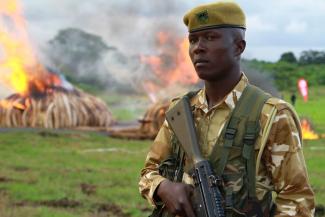Overview
Kenya is globally recognized for its rich biodiversity and iconic landscapes. Kenya’s economy and its citizen's livelihoods depend on their natural resources and nature-based tourism which COVID-19 has diminished. Climate variability, wildlife crime, urban expansion, and rapid population growth threaten Kenya’s conservation efforts. USAID responds to these threats by expanding the conservancy model(link is external).
Biodiversity Conservation
Sixty-five percent of Kenya’s iconic wildlife live outside the national parks. USAID and Kenya Wildlife Service pioneered the community conservancy model in Kenya to support better coexistence between communities and wildlife. Our approach protects wildlife, expands economic opportunities, and enhances the ability of people and land to withstand climate variability and shocks. Collaborative local solutions are paving the way for sustainable conservation outcomes. Community conservancies offer a pathway to recovery from the impacts of COVID and remain essential in combating wildlife trafficking and protecting Kenya’s diverse and rich biodiversity.
USAID has formed innovative partnerships with Kenya Wildlife Conservancies Association, Northern Rangelands Trust, Maasai Mara Wildlife Conservancies Association, and Laikipia Conservancies Association(link is external). Together, we conserve 7 million hectares of land on which 200 conservancies ensure that wildlife thrives and communities benefit from natural resources. Eleven percent of Kenya’s land is currently under conservancy management with USAID’s support.
Combating Wildlife Trafficking
USAID has built a strong coalition of governmental and intergovernmental agencies to address the transnational threat of wildlife crime. We work with local and international partners, including Kenya Wildlife Service, the U.S. Department of Interior, WildlifeDirect, and local communities to counter wildlife trafficking. Our programs enhance wildlife management, raise awareness on wildlife conservation and zoonotic diseases, and help prosecute wildlife crimes. We also provide support to research and technologies that explore innovative ways to protect animals.
Climate Action
The U.S. Government rejoined the Paris Climate Agreement in 2021. Together, the United States and Kenya will amplify their commitment to climate change through Kenya’s Vision 2030. Kenya’s commitment to a low emissions economy and climate adaptation are key components. USAID works with Kenya’s legislative framework to reduce greenhouse gas emissions and help Kenyans adapt to the impacts of climate change. USAID engages with the private sector and Kenya’s policy framework to develop a climate strategy to enact the priorities of the Kenyan and American governments. COP27 will be held in Egypt this year, providing a good opportunity for Kenya to discuss issues in the region.
STORIES
This Rhino is My Son(link is external)
Rescuing a baby Elephant in Kenya(link is external)
NEWSLETTER
You can access our current and past newsletters here.

Eric Onyiego / USAID Kenya and East Africa
